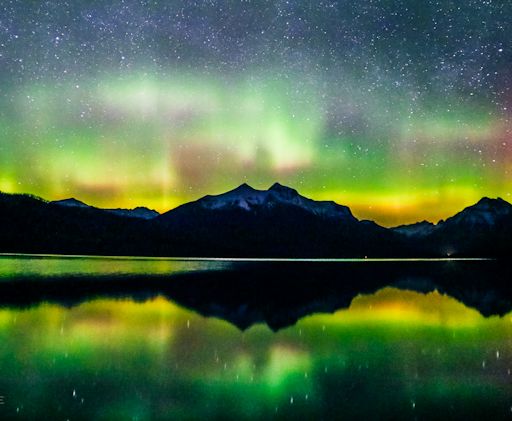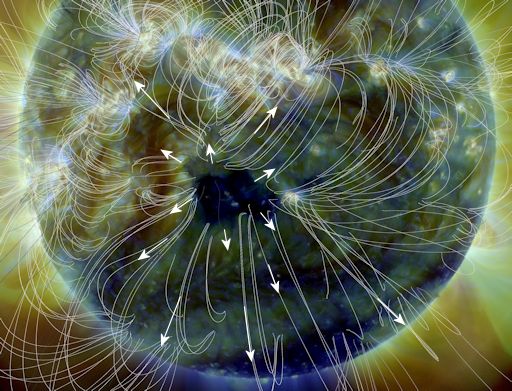Come to Tromsø and share Marianne's passion for rural photography: Chasethelighttours.co.uk invites you to experience "Heaven on Earth" with an aurora, fjord, fishing, whale watching, photography or sightseeing tour. | | | CHANCE OF EARTH-DIRECTED FLARES: Solar activity is low, but sunspot AR2321 is poised to break the quiet. The sprawling sunspot group is directly facing Earth and has an unstable 'beta-gamma' magnetic field that harbors energy for significant eruptions. NOAA forecasters estimate 40% chance of M-flares and a 10% chance of X-flares during the next 24 hours. Solar flare alerts: text, voice. SUBSIDING STORM: Earth is exiting a stream of high-speed solar wind that has been blowing around our planet for days. During the period of peak gustiness on April 16-17, a G2-class geomagnetic storm broke out, sparking bright auroras over Scandinavia, Canada, and northern-tier US states. Kameron Barge photographed the colorful lights over Glacier National Park in Montana: 
"The sky was calm and clear--perfect conditions for this brilliant display of dancing lights," says Barge. Elsewhere in the USA, auroras were sighted as far south as Wyoming, Washington, Michigan, Minnesota, and Idaho. The auroras will fade this weekend as Earth moves out of the solar wind stream. However, we should keep in mind that intermittent flare-ups are possible even as the solar wind subsides. NOAA forecasters estimate a 40% chance of renewed geomagnetic storms during the next 24 hours. Aurora alerts: text, voice. Realtime Aurora Photo Gallery CORONAL HOLE: NASA's Solar Dynamics Observatory (SDO) is monitoring a hole in the sun's atmosphere--a "coronal hole." It is colored deep-blue in this extreme UV image of the sun taken by SDO on April 17th: 
Coronal holes are places where the sun's magnetic field opens up and allows solar wind to escape. In the image, above, the sun's magnetic field is traced by white loops. Arrows show the flow of material out of the hole. Holes in the sun's atmosphere are not unusual; they appear several times each month. A stream of solar wind flowing from this particular coronal hole will probably reach Earth on April 21-22. This means we could have auroras for Earth Day. Stay tuned. Aurora alerts: text, voice Realtime Space Weather Photo Gallery
Realtime Eclipse Photo Gallery
Realtime Comet Photo Gallery
Every night, a network of NASA all-sky cameras scans the skies above the United States for meteoritic fireballs. Automated software maintained by NASA's Meteoroid Environment Office calculates their orbits, velocity, penetration depth in Earth's atmosphere and many other characteristics. Daily results are presented here on Spaceweather.com. On Apr. 18, 2015, the network reported 9 fireballs.
(9 sporadics)  In this diagram of the inner solar system, all of the fireball orbits intersect at a single point--Earth. The orbits are color-coded by velocity, from slow (red) to fast (blue). [Larger image] [movies] Potentially Hazardous Asteroids ( PHAs) are space rocks larger than approximately 100m that can come closer to Earth than 0.05 AU. None of the known PHAs is on a collision course with our planet, although astronomers are finding new ones all the time. On April 18, 2015 there were potentially hazardous asteroids. Notes: LD means "Lunar Distance." 1 LD = 384,401 km, the distance between Earth and the Moon. 1 LD also equals 0.00256 AU. MAG is the visual magnitude of the asteroid on the date of closest approach. | | The official U.S. government space weather bureau | | | The first place to look for information about sundogs, pillars, rainbows and related phenomena. | | | Researchers call it a "Hubble for the sun." SDO is the most advanced solar observatory ever. | | | 3D views of the sun from NASA's Solar and Terrestrial Relations Observatory | | | Realtime and archival images of the Sun from SOHO. | | | from the NOAA Space Environment Center | | | the underlying science of space weather | | 
